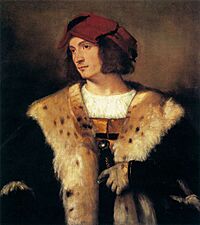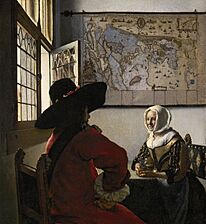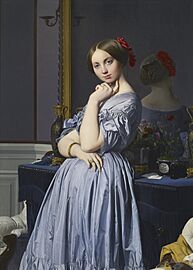Frick Collection facts for kids

The museum's beautiful courtyard garden.
|
|
| Established | December 16, 1935 |
|---|---|
| Location | 1 East 70th Street Manhattan, New York, U.S. |
| Type | Art |
| Public transit access | Subway: Bus: M1, M2, M3, M4, M66, M72, M98, M101, M102, M103 |
The Frick Collection is a famous art museum in New York City. It is located on the Upper East Side of Manhattan in the former home of a wealthy businessman named Henry Clay Frick. When Frick died in 1919, he left his house and his amazing art collection to the public. The museum officially opened in 1935.
The collection features European paintings, sculptures, and furniture from the 1300s to the 1800s. You can see masterpieces by famous artists like Rembrandt, Vermeer, and Goya. The museum is special because the art is displayed inside the beautiful rooms of the Henry Clay Frick House, making it feel like you're visiting a grand home.
The Frick also includes the Frick Art Research Library. This is a major center for art history research. It was started by Frick's daughter, Helen Clay Frick, in 1920. The museum recently finished a major renovation and reopened to the public in April 2025.
Contents
History of the Museum
Henry Clay Frick was a successful industrialist who made his fortune in the steel industry. He loved art and began collecting paintings in the 1880s. He once said, "I can make money... I cannot make pictures." He wanted to create a collection that people could enjoy for many years.
In 1905, Frick and his family moved to New York City. He hired an architect to design a grand mansion at 1 East 70th Street. The house was finished in 1914 and was designed specifically to display his growing art collection.
Creating a Public Museum
When Frick died in 1919, his will stated that his house should become a museum. His wife, Adelaide Howard Childs Frick, continued to live there with their daughter, Helen. After Adelaide's death in 1931, the plan to create the museum could finally begin.
The famous architect John Russell Pope was hired to turn the house into a museum. He made changes to the building, including adding a new wing for the library. The Frick Collection officially opened to the public on December 16, 1935. At first, admission was free, but visitors needed timed tickets to prevent overcrowding.
Growing and Changing
Over the years, the museum grew. It bought neighboring townhouses for more space and added new artworks to the collection. In the 1940s, during World War II, many of the most valuable artworks were moved to a secure vault for safety.
In 1977, the museum completed an expansion that added a new wing and a beautiful garden designed by Russell Page. This helped the museum welcome more visitors and host temporary exhibitions. The museum also began charging a small admission fee to help with rising costs.
Renovations and a Temporary Home
By the 2010s, the historic house needed major updates to meet modern needs. The museum announced a large renovation project. To keep the collection available to the public, the museum moved to a temporary home.
From 2021 to 2024, the collection was displayed at a building on Madison Avenue, called the Frick Madison. This allowed people to see the famous artworks in a new, modern setting. The original Frick House reopened in April 2025 with updated galleries and new spaces for visitors to enjoy.
The Art Collection
The Frick's collection includes about 1,800 pieces of art. This includes paintings, sculptures, furniture, and porcelain. Henry Clay Frick's original collection was the heart of the museum, but new pieces have been added over the years.
The museum is known for its "Old Master" paintings, which are works by Europe's greatest artists before 1800. The art is displayed in 19 different galleries, many of which were once the living spaces of the Frick family.
Famous Paintings
Frick collected many important paintings during his lifetime. His collection includes works by some of the most famous artists in history. Some of the artists featured are:
- Giovanni Bellini
- François Boucher
- John Constable
- Jean-Honoré Fragonard
- Thomas Gainsborough
- El Greco
- Francisco Goya
- Hans Holbein the Younger
- Rembrandt
- Titian
- J. M. W. Turner
- Diego Velázquez
- Johannes Vermeer
- James McNeill Whistler
Highlights of the collection include three paintings by Johannes Vermeer, which is rare because he created very few works. You can also see Rembrandt's famous Self-Portrait and Fragonard's series of large paintings called The Progress of Love.
Sculptures and Decorative Arts
Besides paintings, the Frick has an impressive collection of other art forms. This includes Renaissance bronze sculptures, beautiful 18th-century French furniture, and colorful Limoges enamels.
Many of these objects were bought to complement the paintings and the rooms of the house. For example, Frick purchased a set of Chinese porcelains and French clocks that add to the mansion's elegant atmosphere. The collection also features tapestries that once belonged to French kings.
Selected Works
-
Giovanni Bellini, St. Francis in Ecstasy, 1478
-
Titian, Portrait of a Man in a Red Cap, c. 1516
-
Hans Holbein the Younger, Portrait of Thomas More, 1527
-
Hans Holbein the Younger, Portrait of Thomas Cromwell, 1532 or 1533
-
Pieter Bruegel the Elder, Three Soldiers, 1568
-
El Greco, Saint Jerome, c. 1590–1600
-
Rembrandt, The Polish Rider, 1655
-
Rembrandt, Self-Portrait, 1658
-
Johannes Vermeer, Officer and Laughing Girl, 1657
-
Johannes Vermeer, Girl Interrupted at Her Music, 1658–1661
-
Johannes Vermeer, Mistress and Maid, 1667
-
François Boucher, The Four Seasons (Spring), 1755
-
1755 Francois Boucher Summer anagoria.jpg
François Boucher, The Four Seasons (Summer), 1755
-
1755 Francois Boucher Autumn anagoria.jpg
François Boucher, The Four Seasons (Autumn), 1755
-
François Boucher, The Four Seasons (Winter), 1755
-
John Constable, The White Horse, 1819
-
J. M. W. Turner, The Harbour of Dieppe, 1826
-
J. M. W. Turner, Cologne, the Arrival of a Packet Boat in the Evening, 1826
-
J. M. W. Turner, Mortlake Terrace: Early Summer Morning, 1826
-
Agnolo di Cosimo (Bronzino), Portrait of Ludovico Capponi, 1551
-
Jean-Honoré Fragonard, The Secret Meeting, 1771
-
Jean-Honoré Fragonard, The Progress of Love – Love Letters, 1771–1772
-
Francisco Goya, The Forge, 1817
-
Jean Auguste Dominique Ingres, Portrait of Comtesse d'Haussonville, 1845
-
Pierre-Auguste Renoir, Mother and Children (La Promenade), 1875–76
-
James McNeill Whistler, Harmony in Pink and Grey (Portrait of Lady Meux), 1881
-
Giovanni Battista Tiepolo, Perseus and Andromeda, 1730–31
-
Gentile Bellini, Doge Giovanni Mocenigo, 1478–1485
-
Thomas Lawrence, Portrait of Julia, Lady Peel, 1827
Programs and Events
The Frick Collection offers many programs for the public. It hosts temporary exhibitions, concerts, classes, and lectures. These events help people learn more about art and history.
Temporary Exhibitions
While the Frick is famous for its permanent collection, it also hosts special temporary shows. These exhibitions often focus on a single artist or a specific theme. For example, the museum has shown works from other famous museums, like the Mauritshuis in the Netherlands and the Scottish National Gallery. These shows give visitors a chance to see art that is not usually on display at the Frick.
Concerts and Classes
Since 1938, the museum has hosted a popular concert series. Famous musicians from around the world have performed in the museum's music room. The Frick also offers educational programs, including online classes for students and talks where experts discuss a single work of art in great detail.
The Frick Art Research Library
Next to the museum is the Frick Art Research Library. It was founded by Helen Clay Frick in 1920. The library is one of the world's leading institutions for studying art history.
The library's collection includes hundreds of thousands of books, photographs, and art auction catalogs. It is a valuable resource for students, scholars, and anyone with a serious interest in art. The library is open to the public free of charge.
Visiting the Museum
The Frick Collection is located on Fifth Avenue's Museum Mile, a stretch of road with many museums. The museum charges an admission fee, but it also offers "pay-what-you-wish" hours and free admission on certain days.
To protect the art and furniture, children under the age of 10 are not allowed in the galleries. The museum provides free audio guides that give interesting information about the artworks and the house itself.
Images for kids
See also
 In Spanish: Colección Frick para niños
In Spanish: Colección Frick para niños
- Cooper–Hewitt, National Design Museum, a similar museum further north on Fifth Avenue
- List of museums in New York City
- List of museums and cultural institutions in New York City




































